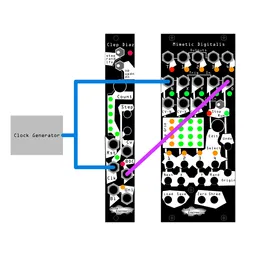The Loquelic Iteritas Percido is known for being a bit of a noisemaker. You may have heard us refer to it as the lasers and space farts module. For those who haven’t used it, the LIP is a voice module based around our complex oscillator, the Loquelic Iteritas. On top of the normal LI features, it includes an output VCA and envelope so that it can act as a voice, as well as a routing matrix that allows that envelope to modulate any of the parameters on LI. Because it’s a complex oscillator that can modulate itself in a slew of ways, it’s quite easy to get into pretty noisy territory with it. However, it has a gentle side to it as well, and today we’ll be looking at three patches that bring out some more traditional tones.
You may also notice a bit of a different look to the videos today: welcome Shanda, aka Trovarsi, to the blog! She’ll be handling videos from here out.
On to the patches!
Patch one: “subtractive”
LIP tends to get noisy when you introduce inharmonic (read: out-of-tune) modulation from the second oscillator, which LIP makes easy to do. There are ways to get around that (more on that in a bit), but there are a lot of sounds we can make with just a single oscillator, too. This one is a personal favorite: by using the internal envelope to modulate the Morph parameter, we can emulate a traditional subtractive pluck. The patch looks like this:

This one surprised me when I first stumbled upon it, as it’s a pretty convincing emulation of a lowpass filter, and it works well for a lot of things I’d normally use a subtractive voice for. Neat!
Patch two: FM bells
Did you know that your LIP can do a pretty convincing emulation of FM? NO? Well, you do now. To make this work nicely, we need to tune our oscillators to a nice ratio that won’t be too inharmonic. For this example, oscillator B is tuned two octaves higher than oscillator A. How do we do this? Tuning LIP’s oscillators is easier than you might expect. First, switch Algo to the PM position, as that’s the algorithm we’ll be using for this sound. Set all the envelope sends to 12 o’clock so they’re not doing anything. Set the four tonal parameters fully counterclockwise, and switch the Mode to Free. You should just hear something close to a sine wave. Switch Master to A, then use the A pitch encoder to find a base frequency that you like. Then, switch Master to B, and use the B pitch encoder to tune oscillator B to a frequency two octaves above A (you can use a tuner like Soleo Vero for this, or switch Master back and forth to do it by ear).
Now, all we have to do is make this patch, and we have some nice FM bells.

This is a pretty nice sound that falls into the more traditional realm of 90s FM synthesis. It’s a great starting point, too: add some Fold or Morph and things start to get a little more harsh. Here’s an example of how this can sound.
Learn more:
Patch three: Supersync!
I’m a huge fan of traditional dual-saw sync basses. Even with alllll the different types of synthesis and sound generation techniques there are today, I always fall back on them as a bit of a staple. And wouldn’t you know it, LIP can make a pretty solid emulation of one! This one’s easy to patch up; we don’t even have to tune it too carefully. Just follow this patch, and then adjust Oscillator B’s pitch to taste. A lot of the tone comes from the relationship between oscillator B’s pitch relative to oscillator A, so it’s also a great modulation destination in your patches, too.

Basics covered. Now we want to hear this patch!






